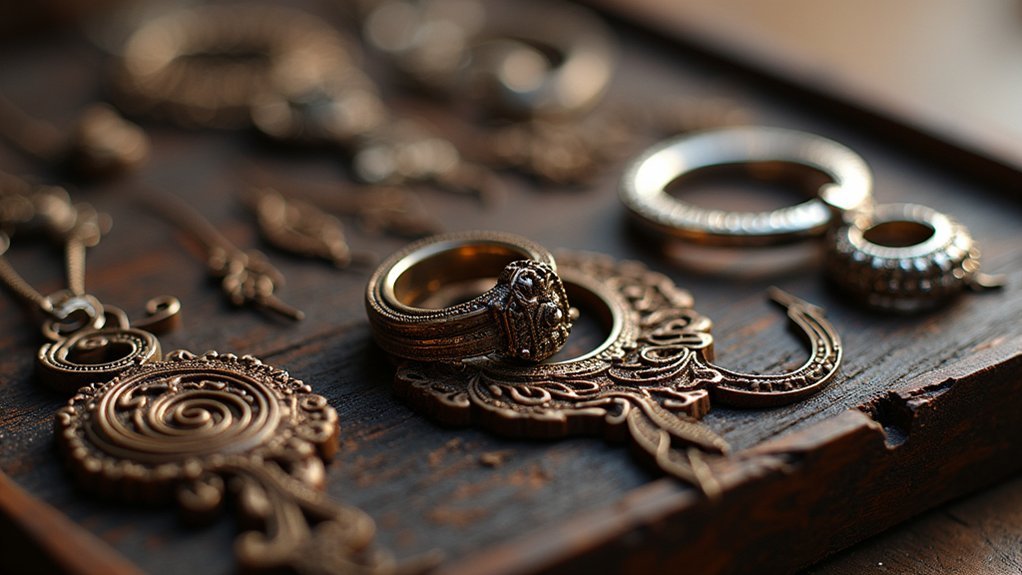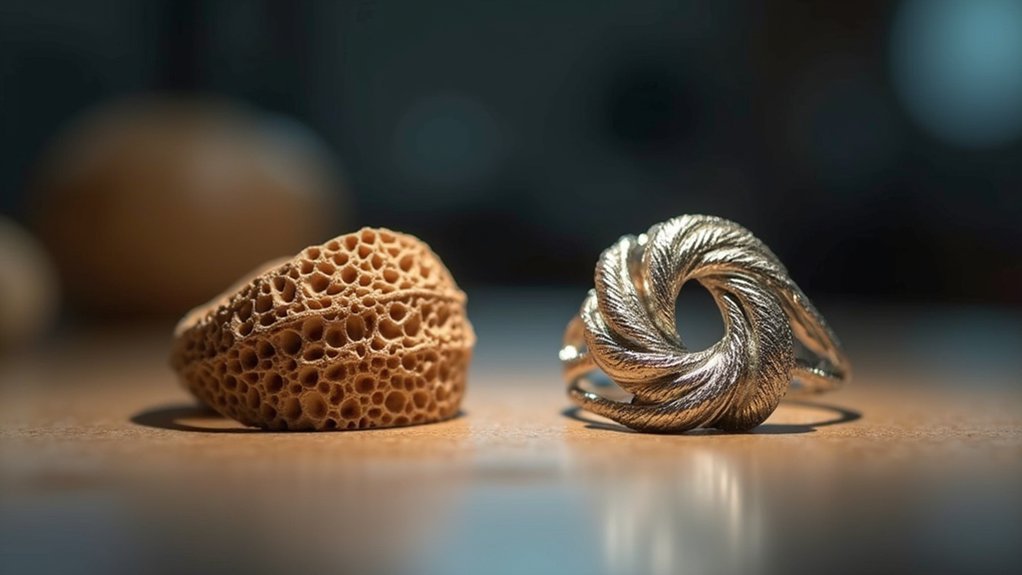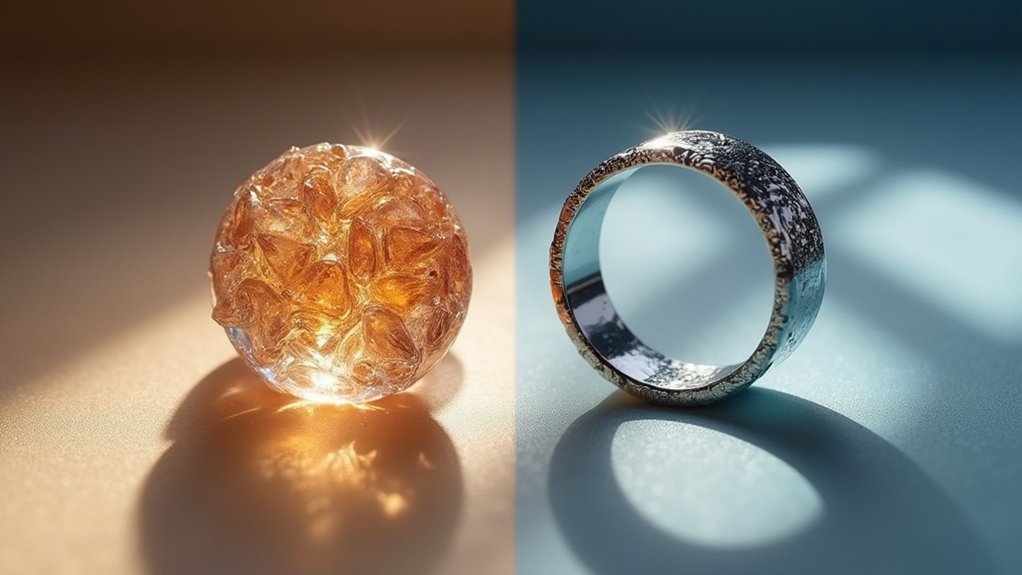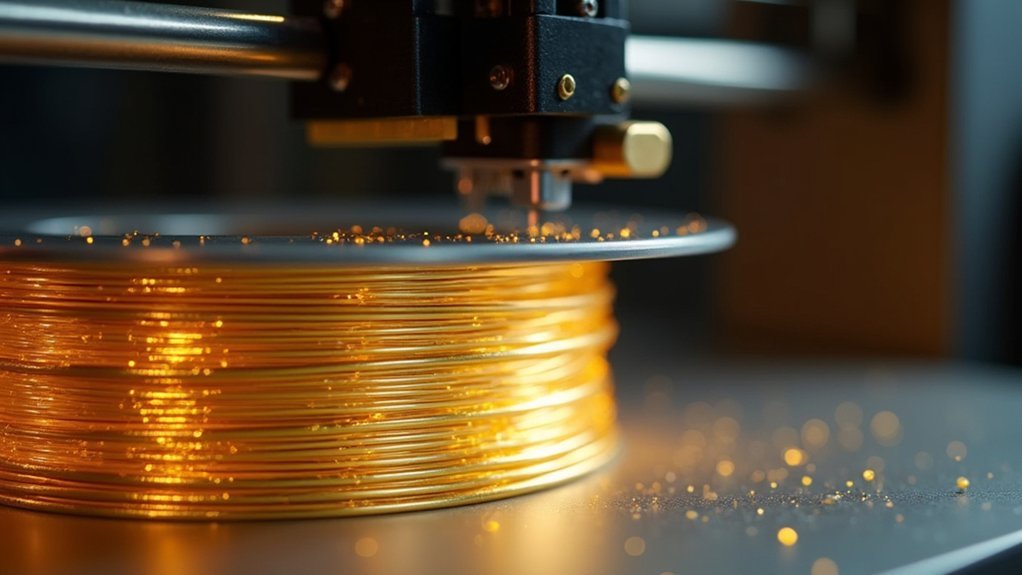You’ll find that 3D printing typically outperforms digital carving for jewelry production in speed, cost, and design complexity. While digital carving uses CNC machines to precisely cut materials like wax and metals, 3D printing creates intricate designs through additive manufacturing with specialized resins. 3D printing reduces production time from weeks to days, cuts labor costs by up to 70%, and enables complex geometries impossible with traditional carving methods. Understanding each method’s specific advantages will help you make the best choice for your jewelry business.
Understanding Digital Carving Technology in Jewelry Making

Digital carving has revolutionized jewelry making by introducing Computer Numerical Control (CNC) machines that carve materials like wood, metal, or wax with exceptional precision based on your digital models.
CNC technology transforms jewelry creation through digital precision, enabling artisans to carve intricate designs impossible with traditional hand methods.
This technology enables you to create intricate designs with complex shapes and patterns that’d be nearly impossible through traditional hand-carving methods.
You’ll find that CNC machines integrate seamlessly with CAD software tools, allowing easy modifications and adjustments before carving begins.
This digital design approach greatly reduces production time compared to manual techniques while promoting efficiency in your manufacturing workflow.
Additionally, you’ll minimize material waste since these machines cut with high accuracy, ensuring only necessary materials are used in your jewelry making process, ultimately enhancing both precision and cost-effectiveness.
How 3D Printing Works for Jewelry Production
Three revolutionary technologies transform how you’ll create jewelry through 3D printing: Computer-Aided Design (CAD) software generates your digital models, which specialized 3D printers then convert into physical objects using additive manufacturing techniques.
This digital workflow enables you to produce intricate designs that would be nearly impossible using traditional methods.
You’ll typically use Stereolithography (SLA) or Digital Light Processing (DLP) printers, which cure photopolymers layer by layer to achieve exceptional detail resolution.
Most jewelry production employs indirect 3D printing, where you’ll create castable resin models for traditional lost wax casting processes rather than printing final metal pieces directly.
After printing, you’ll clean and prepare your pieces for casting, then finish through polishing and refinement steps to achieve professional quality standards.
Traditional Craftsmanship Meets Modern Digital Tools

While 3D printing revolutionizes jewelry production through advanced technology, you’re witnessing an exciting convergence where age-old craftsmanship techniques blend seamlessly with cutting-edge digital tools.
You can now combine traditional hand-carving skills with CAD software and rapid prototyping capabilities, creating pieces that showcase both artistry and precision.
When you integrate these approaches, you’ll achieve complex jewelry design possibilities that weren’t feasible with traditional craftsmanship alone.
Digital tools enable you to streamline workflows, reduce production costs, and offer personalized pieces to broader audiences.
Digital technology transforms jewelry making by optimizing production efficiency, cutting costs, and enabling mass customization for diverse customer bases.
This collaboration enhances your creative potential while maintaining the quality and detail that defines exceptional jewelry.
You’re not replacing traditional methods—you’re amplifying them through strategic use of modern technology, resulting in superior craftsmanship and innovative designs.
Design Complexity and Detail Capabilities Compared
When examining the intricate capabilities of each method, you’ll discover that 3D printing considerably outperforms digital carving in producing complex jewelry designs.
While traditional methods require extensive manual skills and face limitations with delicate details, 3D printing excels at creating filigrees and pavé settings through advanced SLA technology and castable resins.
You’ll find the design process considerably streamlined with 3D printing, as elaborate patterns emerge directly from CAD models without human error.
This technology enables rapid prototyping for quick modifications and iterations, making customized pieces more accessible.
Jewelry manufacturers benefit from 3D printing’s ability to create impossible geometries that traditional carving can’t achieve.
Unlike hand-carved variability, intricate designs remain consistent through digital files, ensuring accurate reproduction of detailed pieces while expanding creative possibilities for innovative jewelry.
Material Options and Compatibility for Each Method

When you’re choosing between digital carving and 3D printing for jewelry creation, you’ll find each method works with distinctly different material sets that directly impact your design possibilities.
Digital carving lets you work with traditional materials like wax, wood, and soft metals that you can hand-finish, while 3D printing opens up options for specialized resins, thermoplastics, and castable wax materials engineered specifically for jewelry applications.
Understanding how these materials interact with each technique—and whether they’re compatible across methods—becomes essential for planning your production workflow and achieving your desired final results.
Digital Carving Material Types
Material selection forms the foundation of any successful jewelry project, whether you’re using digital carving or 3D printing techniques. When you choose digital carving for jewelry creation, you’ll work with materials that offer exceptional durability and natural beauty.
| Material Type | Characteristics | Best Applications |
|---|---|---|
| Hardwood | Dense, durable finish | Statement pieces, rings |
| Softwood | Easy to carve, affordable | Prototypes, practice pieces |
| Plastics/Acrylics | Smooth surface, colorful | Modern designs, displays |
Digital carving excels with rigid materials that CNC machines can precisely shape into intricate designs. Unlike 3D printing, you won’t use castable wax resins since the carving process removes material rather than building layers. Your finished pieces will have tactile, organic finishes that showcase natural material properties.
3D Printing Material Options
3D printing opens up a vastly different material landscape that transforms how you approach jewelry creation.
You’ll find castable resins specifically formulated for investment casting, delivering exceptional detail and smooth finishes that jewelry designers demand. These materials seamlessly integrate with traditional casting processes, bridging digital innovation with established metalworking techniques.
For direct metal printing, you can work with titanium, stainless steel, gold, and silver using advanced 3D printing technology like Direct Metal Laser Sintering. This eliminates traditional molds entirely, enabling intricate geometries previously impossible to achieve.
Your material choice dramatically affects durability, weight, and appearance.
Consider compatibility carefully—SLA printers excel with photopolymers, while FDM systems handle thermoplastics like PLA and ABS effectively for prototyping phases.
Cross-Method Material Compatibility
Understanding how materials behave across digital carving and 3D printing reveals fundamental differences that’ll shape your design approach.
Digital carving typically works with wax, wood, and soft metals using traditional tools, while 3D printing accommodates diverse materials from plastics to precious metals through specialized processes.
Your material choice depends on compatibility requirements. Digital carving needs materials that withstand mechanical cutting stress, limiting options to physically robust substances.
In contrast, printing technologies like SLA use photopolymers for intricate designs, curing under UV light.
Castable resin bridges both methods effectively. You can print detailed patterns, then use traditional lost wax casting techniques.
This combination enhances precision while reducing carving errors.
3D printing’s innovative materials, including composite filaments and bioresins, expand your creative possibilities beyond digital carving’s physical limitations.
Speed and Efficiency in Production Workflows

When you’re comparing digital carving to 3D printing, production speed becomes a critical factor in your workflow decisions.
You’ll find that 3D printing drastically cuts your production time from weeks to just days, while digital carving requires considerably more hands-on work and longer processing periods.
The automation benefits of 3D printing also streamline your entire workflow, reducing manual labor and allowing you to focus on design refinement rather than production bottlenecks.
Production Time Comparison
Speed becomes a critical differentiator when you’re comparing digital carving and 3D printing workflows in jewelry production.
You’ll find that 3D printing dramatically cuts your production time from weeks to days, while traditional lost wax casting methods require extensive hand-crafting that slows your entire production process.
Your workflow acceleration comes from these key advantages:
- Rapid prototyping – You can test multiple design iterations quickly using CAD software.
- Automated manufacturing – Complex steps get streamlined without manual intervention.
- Real-time adjustments – You receive immediate customer feedback for on-site modifications.
- Enhanced capacity – You can fulfill more custom orders with intricate designs efficiently.
When you’re creating complex jewelry pieces, 3D printing outperforms traditional methods by automating labor-intensive processes, giving you faster turnaround times for demanding projects.
Workflow Automation Benefits
Beyond raw speed improvements, workflow automation transforms how you manage your entire jewelry production pipeline. When you integrate digital design with 3D printing, you’ll achieve high precision and repeatability that minimizes human error while enhancing quality.
This automation enables you to create intricate designs that would be time-consuming or impossible with traditional hand-carving methods.
You’ll dramatically reduce production time through rapid prototyping and quick design adjustments. On-site digital capabilities eliminate lengthy customer communication cycles, facilitating faster feedback and decision-making.
By lowering labor costs and reducing material waste through efficient processes, workflow automation makes customized jewelry more accessible and financially viable.
Whether you’re a small-scale jeweler or larger manufacturer, automated workflows streamline your entire creation process from concept to completion.
Cost Analysis for Independent Jewelers and Studios
While traditional jewelry-making methods have dominated the craft for centuries, the financial landscape for independent jewelers shifts dramatically when comparing digital carving to 3D printing technologies.
Your cost analysis reveals compelling advantages when adopting 3D printing over traditional methods.
Consider these financial benefits you’ll experience:
- Initial Investment: Desktop printers like Form 3+ cost $3,500-$5,000 versus traditional carving tools exceeding $10,000
- Labor Reduction: Cut labor costs by up to 70% through automated design modifications
- Production Time: Decrease creation time from weeks to days, boosting revenue potential
- Material Efficiency: Eliminate expensive mold-making processes while maintaining similar material costs
You’ll produce customized pieces at a fraction of traditional costs, enabling personalized designs without extensive manual labor or expensive tooling investments.
Customization and Personalization Possibilities

Every custom jewelry order becomes an opportunity to tell a unique story when you harness 3D printing’s personalization capabilities.
You’ll find that customization reaches new heights through digital workflows, allowing you to modify designs based on customer feedback instantly. With CAD software, you can experiment with intricate designs that were previously impossible through traditional hand-carving methods.
Your clients benefit from 3D printed try-on pieces, letting them visualize and refine their designs before final production. This process enhances satisfaction and reduces costly revisions.
You can now achieve complex gemstone placements and asymmetrical patterns that manual techniques struggle with. The technology’s accessibility means you’re offering bespoke-quality personalization without traditional high costs, making unique pieces available to broader markets.
Quality and Precision in Final Products
When you examine the finished products from 3D printing versus traditional carving, you’ll discover that modern digital technologies consistently deliver superior precision and quality.
Through advanced methods like Stereolithography (SLA), you can achieve intricate details that surpass hand-carving capabilities.
3D printing offers exceptional advantages for your jewelry design:
- Filigree perfection – Delicate wirework patterns emerge with mathematical precision
- Pavé setting accuracy – Stone seats align perfectly for seamless gem placement
- Dimensional consistency – Every measurement matches your digital specifications exactly
- Defect elimination – Castable resins reduce human error in mass production
You’ll find that digital carving techniques enable precise adjustments during the design phase, ensuring exact dimensions critical for fit and finish.
High-temperature-resistant molds capture every intricate detail, consistently delivering professional-grade quality that traditional methods struggle to match.
Equipment Requirements and Investment Considerations
Before diving into jewelry production, you’ll need to evaluate the considerable financial commitment required for each technology. Digital carving demands specialized CNC machines ranging from thousands to tens of thousands of dollars, while entry-level 3D printing equipment like the Formlabs Form 3+ starts around $3,500, making it more accessible for small jewelers.
| Factor | Digital Carving | 3D Printing |
|---|---|---|
| Initial Equipment Cost | $5,000-$50,000+ | $3,500+ |
| Ongoing Maintenance | Higher (calibration, tools) | Lower (resin, parts) |
Both approaches require CAD software for jewelry design, with professional licenses costing $1,000-$3,000, though free alternatives exist. Your investment considerations should align with production goals: CNC machines excel at high-volume manufacturing, while 3D printing suits rapid prototyping and customization. Equipment requirements vary greatly between these technologies.
Choosing the Right Method for Your Jewelry Business
When you’re deciding between digital carving and 3D printing for your jewelry business, you’ll need to weigh the initial investment costs against your production goals.
3D printing offers lower entry costs and faster turnaround times, making it ideal if you’re focused on customization and quick prototyping.
Digital carving requires higher upfront equipment costs and more extensive training, but it provides precise artisanal control that some jewelers prefer for specific techniques.
Cost and Investment Analysis
Although digital carving has long been the traditional choice for jewelry manufacturing, you’ll find that significant cost differences between these two methods can dramatically impact your business’s bottom line.
This cost and investment analysis reveals why many jewelers are shifting toward 3D printing technology.
Initial Investment Comparison:
- Equipment costs: Digital carving requires substantial upfront investment, while 3D printing offers desktop models starting at $2,000.
- Material expenses: Traditional premium waxes and metals versus affordable castable resins.
- Operational costs: Faster 3D printing turnarounds reduce labor expenses and increase monthly output.
- Customization options: Quick design modifications enhance sales without remaking expensive molds.
3D printing’s lower operational costs, combined with expanded customization options, position your business for higher long-term returns as bespoke jewelry demand continues growing.
Production Speed Comparison
Speed determines everything in today’s competitive jewelry market, and the production timeline differences between digital carving and 3D printing can make or break your ability to meet customer demands.
With 3D printing, you’ll move from design to finished jewelry pieces in days, while traditional digital carving requires weeks or months. Rapid prototyping becomes your competitive advantage, enabling quick design iterations and faster customer feedback loops.
3D printing automates multiple production steps that digital carving handles manually, dramatically reducing your production speed bottlenecks.
Advanced SLA and DLP technologies deliver intricate designs with precision that’d take considerably longer through traditional methods. You’ll eliminate time-consuming handcrafting processes while maintaining quality, allowing you to respond quickly to market trends and customer requests.
Frequently Asked Questions
Can a 3D Printer Print Jewellery?
You can absolutely use a 3D printer to create jewelry. You’ll achieve intricate designs with high precision using SLA or DLP techniques, then cast them in metal for stunning final pieces.
What Metals Cannot Be 3D Printed?
You can’t 3D print highly reactive metals like magnesium, precious metals like pure gold requiring special methods, high-melting-point metals like tungsten, and toxic materials like lead due to safety regulations.
Is It Safe to Wear 3D Printed Resin Jewelry?
You can safely wear 3D printed resin jewelry if it’s made from skin-safe, hypoallergenic resins and properly post-processed. Always choose pieces explicitly labeled as wearable and avoid exposure to extreme temperatures.
How Long Does It Take to 3D Print Jewelry?
You’ll spend 1-2 hours printing simple jewelry pieces, while intricate designs require up to 10+ hours. Add another 1-3 hours for post-processing like cleaning and curing your printed piece.
In Summary
You’ll find both digital carving and 3D printing offer unique advantages for jewelry creation. Consider your budget, design complexity needs, and production volume when choosing. Digital carving excels at intricate details and traditional finishes, while 3D printing offers rapid prototyping and complex geometries. Don’t limit yourself to one method—many successful jewelers combine both technologies. Start with your specific business goals, then select the technology that’ll best serve your customers and creative vision.





Leave a Reply